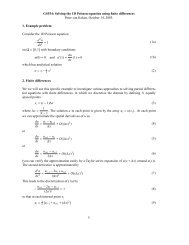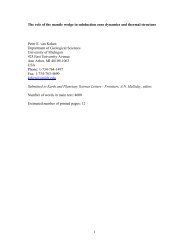Quantitative paleoenvironmental and paleoclimatic reconstruction ...
Quantitative paleoenvironmental and paleoclimatic reconstruction ...
Quantitative paleoenvironmental and paleoclimatic reconstruction ...
Create successful ePaper yourself
Turn your PDF publications into a flip-book with our unique Google optimized e-Paper software.
ARTICLE IN PRESS<br />
N.D. Sheldon, N.J. Tabor / Earth-Science Reviews xxx (2009) xxx–xxx<br />
17<br />
where the SE is ±147 mm yr − 1 , <strong>and</strong> R 2 =0.52 for the empirical<br />
relationship. Using a subset (n=675) of the newly compiled database,<br />
Retallack (2005b) also defined the following relationship for mean<br />
annual range of precipitation (MARP):<br />
MARP = 0:79T +13:7<br />
ð28Þ<br />
where the SE is ±22 mm yr − 1 , R 2 =0.58 for the empirical relationship,<br />
<strong>and</strong> where T is the thickness the paleosol with carbonate nodules<br />
(i.e., Bk horizon thickness; in cm). Application of this new MAP<br />
relationship gives results comparable to estimates from B horizon<br />
geochemistry (see Section 5.5.3) <strong>and</strong> paleobotanical results where the<br />
paleosols conform to all of the criterial listed above (Retallack, 2007;<br />
Sheldon, 2009). However, it should be noted that there are some<br />
modern soil orders that are still not represented within the modern<br />
soil proxy data set. For example, Nordt et al. (2006) point out that<br />
there are essentially no Vertisols in the dataset <strong>and</strong> that no data exists<br />
to quantify the differences in Bk depth between micro-highs <strong>and</strong><br />
micro-lows in Vertisols, an important consideration given cm- to dmscale<br />
micro-relief in most Vertisols. Furthermore, Vertisols (which<br />
often form in strongly seasonal or monsoonal climates) often preserve<br />
dispersed carbonate throughout the profile. Nordt et al. (2006) found<br />
that equation of Retallack (1994) was poor at predicting MAP in a<br />
modern Vertisol climosequence when microhighs were used <strong>and</strong><br />
somewhat effective when microlows were used (though only to Bk<br />
depths of 117 cm or less), but that a different equation fit their data<br />
better <strong>and</strong> that Retallack's (1994) equation systematically underestimated<br />
MAP. For a given soil/paleosol, the predicted MAP using<br />
Eq. (27) is not substantially different than Retallack's (1994) earlier fit<br />
to the data, which suggests that Eq. (27) is not useful for paleo-<br />
Vertisols either. Thus, though Eq. (27) is potentially very broadly<br />
applicable, care must be taken to use it only with appropriate paleosols<br />
types (i.e., not Vertisols), parent material textures (alluvium or loess),<br />
<strong>and</strong> with an underst<strong>and</strong>ing of the geologic age, setting (lowl<strong>and</strong>s), <strong>and</strong><br />
burial history (i.e., decompacted values) of the paleosols.<br />
5.5.3. Bw/Bt horizon geochemistry<br />
During weathering of silicate rocks, minerals such as feldspars are<br />
broken down to form clay minerals by hydrolysis <strong>and</strong> acid attack<br />
reactions (see Section 5.2.2). Water availability is one of the key<br />
controls on the rate of these reactions, so given the same amount of<br />
time, more clay should be formed under a wetter climatic regime than<br />
a dry one (Birkel<strong>and</strong>, 1999; Retallack, 2001b). Thus, Sheldon et al.<br />
(2002) used the soil database of Marbut (1935) <strong>and</strong> modern measurements<br />
of MAP to propose the following relationship between CIA-<br />
K of Bw <strong>and</strong> Bt horizons (Eq. (6); Maynard, 1992) <strong>and</strong> MAP:<br />
<br />
P mm yr − 1<br />
0:0197 CIA−K<br />
= 221:1e ð Þ ð29Þ<br />
where the SE is ±181 mm yr −1 , <strong>and</strong> R 2 =0.72 for the empirical fit.<br />
They also proposed two other proxies for MAP, one based on ΣBases/<br />
Al for the Bw or Bt horizons (Table 3):<br />
<br />
<br />
P mm yr − 1 = − 259:3Ln ΣBases <br />
+ 759 ð30Þ<br />
Al<br />
where the SE ±235 mm yr − 1 , <strong>and</strong> R 2 =0.66 for the empirical relationship.<br />
The other is a Mollisol-specific MAP relationship where:<br />
<br />
P mm yr − 1 = − 130:9LnðCÞ + 467<br />
ð31Þ<br />
where the SE is ±156 mm yr − 1 , C is the molar ratio Ca/Al of the B<br />
horizon, <strong>and</strong> R 2 =0.59 for the empirical relationship.<br />
Bw <strong>and</strong> Bt horizons are used because: 1) they form over long<br />
periods of time, making their chemical composition a function of<br />
equilibrium processes rather than kinetic ones; 2) long formation<br />
times also ensure that short-term climatic volatility (e.g., El Niño)<br />
does not overprint the long-term conditions; 3) there should be a<br />
clear difference between the parent material weathering ratio value<br />
<strong>and</strong> the B horizon value if the proxy is applicable (e.g., for CIA-K, there<br />
should be at least a 5–8 unit difference), <strong>and</strong> if the values are very<br />
close, then the proxy is not applicable. Though the original database of<br />
Marbut (1935) had a wide range of soil types in it, the relationships<br />
are not considered applicable for paleosols with near surface<br />
carbonates or evaporite minerals, for hillslope or montane settings,<br />
or for laterites (Sheldon et al., 2002). Eqs. (29) <strong>and</strong> (30) are both<br />
useful over a range of precipitation values between 200 <strong>and</strong> 1600 mm<br />
yr − 1 . For example, a CIA-K value of 100 (e.g., pure kaolinite) gives a<br />
MAP estimate of 1585 mm yr − 1 , <strong>and</strong> a CIA-K value of 0 (i.e., no<br />
Al present at all) gives a MAP estimate of 221 mm yr −1 . For paleosols<br />
with very well-developed Bk horizons, Eq. (30) is favoured over Eq. (30)<br />
because it gives more consistent results when applied to modern soils;<br />
for other types of paleosols Eq. (29) is preferred both because it is more<br />
precise <strong>and</strong> more accurate.<br />
Eq. (29) has been widely applied to paleosols of a wide range of<br />
ages including Paleozoic (e.g., Driese <strong>and</strong> Ober, 2005; Driese et al.,<br />
2005; Sheldon, 2005) <strong>and</strong> Mesozoic (e.g., Prochnow et al., 2006)<br />
paleosols, <strong>and</strong> has proven particularly useful for Cenozoic (e.g., Hamer<br />
et al., 2007a,b; Kraus <strong>and</strong> Riggins, 2007; Retallack, 2007; Sheldon,<br />
2009; Sheldon et al., 2009) paleosols where diagenesis can be discounted<br />
more easily than for the older paleosols. Two separate lines of<br />
evidence suggest that Eq. (29) is a particularly useful proxy for MAP.<br />
The first is that it produces MAP estimates that are consistent with<br />
independent paleobotanical estimates based on leaf-margin analysis<br />
(Sheldon et al., 2002; Sheldon <strong>and</strong> Retallack, 2004; Retallack et al.,<br />
2004a; Retallack, 2007; Sheldon, 2009) <strong>and</strong> nearest-living relatives<br />
(Retallack et al., 2004a,b; Hamer et al., 2007a,b; Sheldon et al., 2009).<br />
The second is that it generally successfully predicts modern,<br />
measurable MAP in soil climosequences (Driese et al., 2005; Nordt<br />
et al., 2006), even for soil types (i.e., Vertisols) that are not represented<br />
by many soils in the original Marbut (1935) database. For arid<br />
<strong>and</strong> semi-arid settings, it also gives results that are consistent within<br />
error of estimates based on Bk horizon depths (e.g., Sheldon<br />
<strong>and</strong> Retallack, 2004), though typically gives systematically slightly<br />
“wetter” results.<br />
In general, Eq. (29) is the most well-supported proxy for MAP<br />
based on paleosols, however, it must be carefully applied according to<br />
the criteria listed above <strong>and</strong> wherever possible, multiple proxies (e.g.,<br />
Bk depth or paleobotanical estimates) should also be used to confirm<br />
the results. Another important consideration is to be sure that high<br />
CIA-K values are not simply due to inheritance from chemically<br />
mature parent materials. Thus, a useful guideline based on observations<br />
from the original Marbut (1935) database is that there should be<br />
at least a 5–8 unit difference in CIA-K values between the paleosol's<br />
parent material value <strong>and</strong> its B horizon value depending on the field<br />
taxonomic description of the paleosol (at least 5 units for weakly to<br />
moderately developed Orders, N5 units for moderately to strongly<br />
developed Orders). One final consideration is the role that topography<br />
may play in limiting the applicability of Eq. (29). Rasmussen <strong>and</strong> Tabor<br />
(2007) show a generally poor correspondence between CIA-K <strong>and</strong><br />
MAP for some parent materials (though good for others) along<br />
transects of increasing elevation in the Sierra Nevadas. Sheldon et al.<br />
(2002) specifically limited the applicability of Eq. (29) to lowl<strong>and</strong><br />
settings. The results of Rasmussen <strong>and</strong> Tabor (2007) confirm this <strong>and</strong><br />
serve as a good reminder that proxies should be applied carefully in<br />
settings for which they were not defined.<br />
5.6. Long-term chemical weathering<br />
Another potential application of whole rock geochemistry is to<br />
quantify long-term change in chemical weathering. In many continental<br />
basins, long sequences of paleosols spanning many millions of<br />
Please cite this article as: Sheldon, N.D., Tabor, N.J., <strong>Quantitative</strong> <strong>paleoenvironmental</strong> <strong>and</strong> <strong>paleoclimatic</strong> <strong>reconstruction</strong> using paleosols, Earth-<br />
Science Reviews (2009), doi:10.1016/j.earscirev.2009.03.004















